Martina Šlajerová's Blog, page 2
November 11, 2024
Keto Chocolate Brownie Truffles

Today, I���ve got a special treat that���s sure to satisfy any chocolate lover���s cravings! You really need to make these fudgy, rich keto brownie truffles coated in dark chocolate and crunchy macadamias. If you���ve been following my recipes, you know I���m a big fan of RxSugar Allulose, especially their keto-friendly, sugar-free brownie mix. It���s so easy; all you need is water to make delicious, guilt-free brownies!
These brownies are fantastic on their own, but I wanted to take them up a notch by turning them into these decadent truffles. With just a few simple steps, you can enjoy a low-carb dessert that feels truly indulgent without any of the sugar.
Key Ingredients & Easy Swaps
To make these truffles just right, here are some key ingredients and a few simple swaps you can use to customize the flavor:
RxSugar Keto Brownie Mix: The star of this recipe, RxSugar's Keto Brownie Mix (use this link to get 20% off) makes it easy to keep things low-carb and sugar-free. All you need is water to prepare the brownies, so it���s super convenient!
Mascarpone or Cream Cheese: Adds creaminess and helps bind the truffles. You can use either mascarpone for a richer taste or cream cheese for a slightly tangier twist. For a dairy-free option, use thick coconut cream.
Macadamia Nuts: For a delicious crunch, crushed macadamias add the perfect texture and taste to the truffles. If you���d like to try other flavors, swap them out for crushed pistachios, pecans, or toasted shredded coconut. Roasted nuts or coconut can give an even deeper flavor, and for a unique twist, try freeze-dried berries.
Dark Chocolate: For the chocolate coating, use 90% dark chocolate which is ultra low in sugar and perfect for these truffles. Alternatively, use 100% dark chocolate to keep it 100% sugar-free. For a milder coating, blend 3 oz (85 g) of 100% chocolate with 1 oz (28 g) of cacao butter.
Optional Flavor Variations: Add-ins like orange zest, vanilla, cinnamon, or peppermint extract can bring out festive flavors. You can also add a splash of rum, whiskey, or bourbon for a festive taste.
Can I use homemade brownie mix?
If RxSugar Keto Brownie Mix isn���t available in your area, you can use this keto brownie mug cake recipe as a substitute. Simply triple the recipe to get a similar amount to use in this truffle recipe. You might need to add a touch of sweetener to match the results.

Tips for Making the Perfect Brownie Truffles
For the best truffles, here are a few essential tips:
Gentle Cooking: Chocolate can burn easily, so use low heat settings if microwaving. For best results, microwave at half power, rotating the bowl a quarter turn every 30 seconds if your microwave doesn���t have a rotating plate.
Extra Crunch Options: For added texture, you can mix in extra chopped nuts or chocolate chunks before coating the truffles.
Oven Option: If you prefer to use the oven instead of the microwave, bake the brownie mixture at 175��C (350��F) fan-assisted, or 195��C (380��F) conventional for about 15 minutes. If using a smaller, deeper dish, you may need to adjust the baking time slightly as it will take longer to cook through and set.
Roasting Macadamias: If you choose roasted macadamias for coating, keep in mind that macadamias are more resilient than most nuts. They can be roasted at 300��F (150��C) without causing significant oxidation to their fats, unlike walnuts, which are best kept below 265��F (130��C). You can learn all about macadamia nuts in this post.
Storage Tips
Store these truffles in an airtight container in the fridge for up to 1 week to keep them fresh and maintain their texture. For longer storage, place the truffles in a freezer-safe container and freeze for up to 3 months. Thaw them in the refrigerator for a few hours before serving.
These truffles are best enjoyed chilled or at room temperature���perfect for a quick, grab-and-go treat!
Recipes with Allulose You Will Love
If you���re loving these brownie truffles, here are some more low-carb recipes using allulose that make fantastic treats and pair perfectly with a keto lifestyle.
No Fail Fluffy Keto Marshmallows
Keto Creme Caramel (Low-Carb Flan)
Chewy Keto Maple Pecan Granola Bars
Soft & Creamy Keto Vanilla Ice Cream
Smooth & Silky Keto Caramel Sauce
Low-Carb Bourbon Chicken






Preparation time
Hands-on: 25 minutes
Overall: 2 hours
Nutritional values (per serving, 1 truffle)
Total Carbs3.6grams
Fiber2.3grams
Net Carbs1.3grams
Protein3grams
Fat10.5grams
of which Saturated4.9grams
Energy117kcal
Magnesium21mg (5% RDA)
Potassium63mg (3% EMR)
Macronutrient ratio: Calories from carbs (5%), protein (11%), fat (84%)
Ingredients (makes 15 truffles)
170 g RxSugar Keto Brownie Mix (6 oz) - click here to get 20% off
6 tbsp water (90 ml)
1/2 cup mascarpone cheese or cream cheese (120 g/ 4.2 oz)
115 g 90% dark chocolate (4 oz)
1/4 cup macadamia nuts, crushed or roughly chopped (28 g/ 1 oz)
Instructions
In a medium bowl, mix the brownie mix with water until smooth. Pour the mixture into a large ramekin or silicone baking tray. Microwave on half power (500 W) for 3 to 4 minutes, checking every minute.
Note: Click here to get 20% off RxSugar Keto Brownie Mix, or see recipe tips for homemade keto mug brownie.

Carefully remove from the microwave and transfer to a mixing bowl. Let the brownie mixture cool completely.
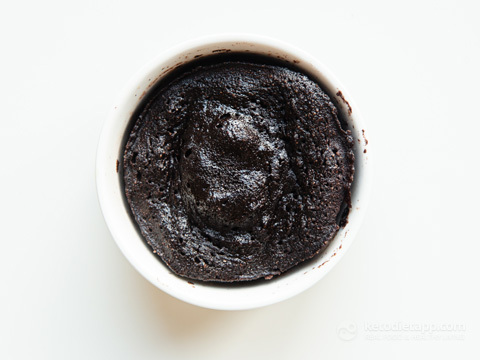
Once cooled, add mascarpone (or cream cheese) to the brownie mixture, stirring until fully combined. Place the bowl in the fridge to chill for 30 minutes. Then, use a cookie scoop or dampened hands to shape into 15 truffles, about 20 g (0.7 oz) each. Arrange the truffles on a tray and freeze for at least 30 minutes, or up to 1 hour.
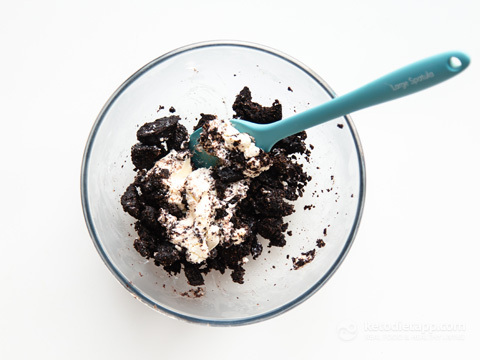
While the truffles chill, melt the dark chocolate in a double boiler or in a glass bowl over a saucepan of simmering water, stirring until smooth. Let it cool slightly before coating, as overly warm chocolate may not coat evenly.
Remove truffles from the freezer. Using a skewer or fork, dip each truffle into the melted chocolate, spooning over the chocolate to coat evenly. Rotate the truffle gently as the chocolate begins to set, then dip into the crushed macadamias. If any chocolate remains, drizzle it over the truffles. Remove the skewer and cover the hole with a dab of chocolate.
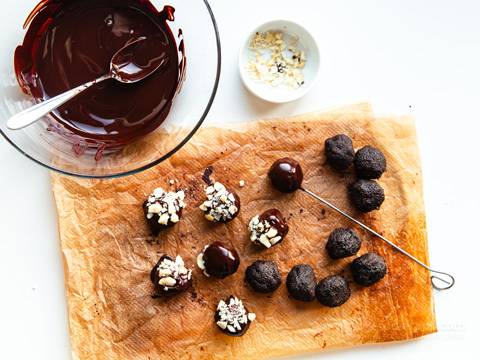
Place each coated truffle on a tray lined with greaseproof paper and refrigerate for at least 15 minutes before serving. Store in the fridge for up to a week or freeze for up to 3 months.

November 7, 2024
The Best Low-Carb Scalloped "Potatoes"

Missing scalloped potatoes on a low-carb or keto diet? This recipe brings you all the creamy, cozy flavors you crave, with a French twist inspired by gratin dauphinois! By using kohlrabi���a mild, neutral-tasting veggie that soaks up the rich, velvety sauce beautifully���you���ll get the same luxurious texture without the carbs.
If you���re looking to mix things up, other low-carb veggies like rutabaga, turnips, celeriac, jicama, or chayote work great too, each adding a unique twist to this classic comfort food. In fact, I made a version with rutabaga (swede) several years ago.
This keto scalloped ���potato��� dish pairs well with almost any main course, making it perfect for holiday dinners, family gatherings, or cozy weeknights at home.
Why You���ll Love This Recipe
Keto-Friendly Comfort Food: All the cozy vibes of scalloped potatoes, without the carbs.
Simple Ingredients: Only a handful of basics needed���no fancy ingredients here.
Customizable: If kohlrabi isn't in season, use other potato swaps like rutabaga (swede) or turnips.
Perfect for Any Occasion: Great as a side for holidays or an easy weeknight meal.
Easy to Reheat: Stays creamy and delicious, even as leftovers.
Key Ingredients & Swaps
This recipe uses just a few simple ingredients that create a creamy, flavorful side dish. Here���s a quick breakdown, plus some low-carb swap options:
Kohlrabi: The star of the dish! Kohlrabi has a mild, neutral taste and a firm, slightly crisp texture that softens beautifully when cooked. It���s an ideal low-carb potato substitute, but you can also use other keto-friendly veggies like rutabaga, turnips, celeriac, jicama, or chayote if you want to change things up.
Heavy Cream: Provides richness and that classic creamy texture. For a dairy-free option, you could try coconut cream, though it will alter the taste.
Butter or Ghee: Adds depth and richness. Both work well, so feel free to use whichever you prefer.
Egg Yolks: These help thicken the sauce. They���re essential for that creamy, custard-like consistency, so no skipping!
Onion and Garlic Powder: Simple seasonings that add a savory boost without overpowering. You can adjust these to taste, or try a dash of nutmeg for a warm twist.
Fresh Herbs: Parsley, chives, or spring onions are optional but add a fresh, bright flavor to the finished dish.
Tips for Making the Perfect Low-Carb Scalloped Potatoes
These tips will help you get that perfect creamy texture and flavor every time:
Slice Evenly: Aim for thin, even slices of kohlrabi so they cook at the same rate.
Cook Before Baking: Boiling the kohlrabi until just tender ensures it bakes evenly and absorbs more flavor. Do not skip this step as the topping would burn before the kohlrabi gets tender.
Temper the Egg Yolks: When adding hot cream to the yolks, go slowly to prevent curdling. This step gives the sauce a smooth, custard-like texture.
Bake Until Golden: Look for a lightly golden top and bubbly edges to know it���s done.
Let It Cool a Bit: Allow the dish to cool for a few minutes before serving.

Storage and Serving Tips
To store, let the scalloped kohlrabi cool completely, then cover and refrigerate for up to 5 days. For best results, reheat in the oven at 350��F (175��C) for about 15-20 minutes, or until warmed through. You can also reheat in the microwave in 30-second intervals until hot, though the oven will keep the texture creamier.
Serving Suggestions
This low-carb scalloped ���potatoes��� dish pairs wonderfully with a variety of mains and sides, making it a versatile choice for any meal. Here are a few great options to try it with:
Low-Carb Ginger Spiced Pork Roast
Spatchcock Chicken with Lemon Herb Marinade
Butter Blanketed Roast Turkey
Garlic, Herb & Mustard Marinated Air Fryer Chicken
Steak with Quick Mustard & Peppercorn Sauce
Seared Pork Chops with Creamy Cheese Sauce







Preparation time
Hands-on: 20 minutes
Overall: 1 hour
Nutritional values (per serving, about 225 g/ 8 oz)
Total Carbs12.6grams
Fiber5.9grams
Net Carbs6.7grams
Protein5.6grams
Fat28grams
of which Saturated17grams
Energy319kcal
Magnesium37mg (9% RDA)
Potassium631mg (32% EMR)
Macronutrient ratio: Calories from carbs (9%), protein (7%), fat (84%)
Ingredients (makes 5 servings)
4 kohlrabi (1 kg/ 2.2 lbs)
1 tbsp butter or ghee (15 g/0.5 oz)
1 1/4 heavy whipping cream (300 ml/ 10 fl oz)
1/2 cup water (60 ml/ 2 fl oz)
3 large egg yolks
1 tsp onion powder
1/2 tsp garlic powder
salt and pepper, to taste
fresh herbs such as parsley, chives or spring onions, to serve
Instructions
Peel the kohlrabi. Cut it in half and then cut into thin slices, about 1/2 cm (1/4 inch) each.
Note: You'll need about 4 pieces, 1 kg/2.2 lbs kohlrabi to get about 800 g/1.76 lbs peeled kohlrabi.

Place the kohlrabi slices in a pot filled with salted water. Bring to a boil over medium-high heat. Once boiling, reduce the heat, cover with a lid, and cook for about 20 to 25 minutes, or until tender.
Note: If using any other potato alternatives like rutabaga, turnips, or celeriac, cooking time will vary so make sure to start checking after 10 and 15 minutes.
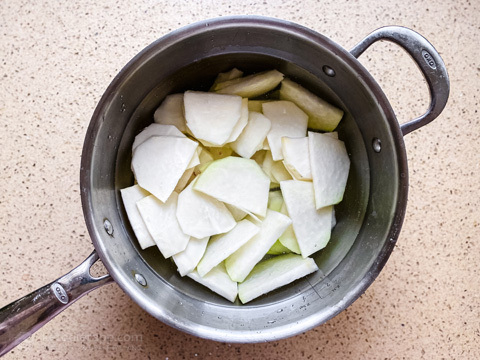
Once the kohlrabi has cooked, take off the heat and drain. Remove the lid and set aside to cool down. Once cool enough to touch, fold the slices vertically into a medium-sized baking dish (at least 1.5 to 2-quart/liter casserole dish). Preheat the oven to 190 °C/ 375 °F (fan assisted), or 210 °C/ 410 °F (conventional).
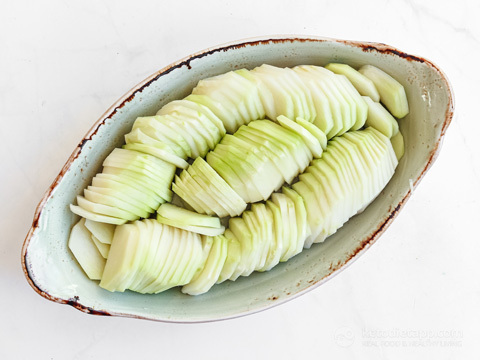
Meanwhile, prepare the creamy sauce. In a small bowl, whisk the egg yolks, onion powder, and garlic powder. Season with a pinch of salt and pepper.
Place the butter, cream, and water in a saucepan. Bring to a boil over medium-high heat. Once foam starts to form, take off the heat.
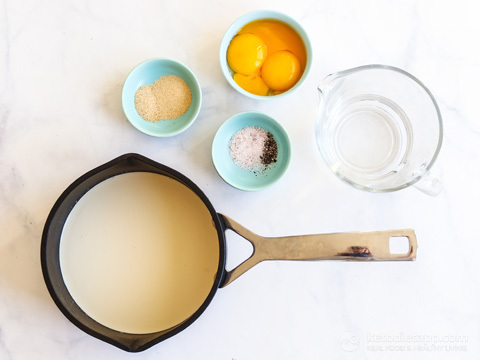
While the cream mixture is still hot, use a ladle to gradually temper the hot cream into the egg yolk mixture, whisking constantly to avoid curdling. When you have added about half of the cream mixture, return everything into the pot with the remaining cream mixture, whisk vigorously, and cook until it reaches 70 °C/ 160 °F (about 5 minutes).
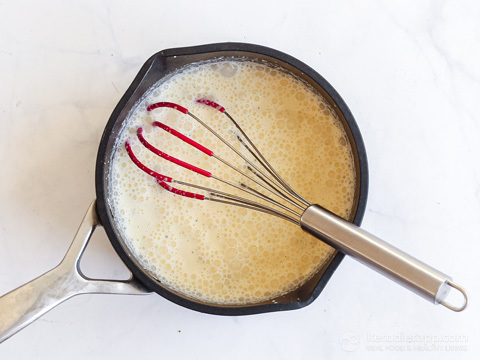
Pour the hot cream mixture over the kohlrabi slices.

Place in the oven and bake for 25 to 30 minutes, until the cream is set and caramelized. Bake longer if you prefer more browning on top.

Remove from the oven and set aside to cool. Serve as a side with roasted meat, fish, or seafood. Optionally, sprinkle with fresh herbs such as parsley, chives, or spring onions. To store, let it cool down and refrigerate for up to 5 days. Reheat in the oven or microwave.

October 17, 2024
Whole Baked Masala Cauliflower

Halloween is the perfect time to try something different, and this Whole Baked Masala Cauliflower fits right in! With its rich, spiced coating and a look that���s kind of creepy (but in a good way), it���s a great way to bring some flavor to the table. Whether you���re hosting a spooky dinner or just want a new side dish, this cauliflower is easy to make, low-carb, and seriously tasty.
Key Ingredients & Swaps
This recipe keeps things simple but flavorful with a few key ingredients. Here���s what you���ll need and some ideas for easy swaps:
Cauliflower: The whole head of cauliflower is the base. If you prefer, you can use a smaller one, but adjust the cooking times to avoid overcooking.
Soft Cheese: Soft goat cheese adds a nice tang, but cream cheese is a great swap if you prefer something milder.
Tomato Paste: If you don���t have tomato paste (tomato puree), a thick tomato sauce could work.
Spices: Garam masala and curry powder bring in the classic masala flavors. You can adjust the spice level by using mild or hot curry powder. Don't have garam masala? A blend of cumin, coriander, and a little cinnamon will do the trick.
Olive Oil: You could swap it for avocado oil or melted ghee.
Herbs: Fresh parsley or cilantro are perfect to sprinkle on top, but you can use other fresh herbs you like, such as mint or chives, to change the flavor profile.
Tips for Making the Perfect Whole Baked Cauliflower
To get the best results with this dish, here are a few simple tips:
Don���t skip the steaming. Steaming the cauliflower first ensures it���s tender all the way through without drying out in the oven. Aim for crisp-tender when steaming, so it holds its shape while roasting.
Let the cauliflower cool a bit before marinating. This helps the cheesy masala coating stick better and not slide off.
Use a generous coating of the marinade. Make sure the cauliflower is completely covered with the spiced cheese mixture to maximize flavor and prevent it from drying out.
Broil for extra color. If you want an even crispier top, broil the cauliflower for the last few minutes of baking, but keep an eye on it so it doesn���t burn.
Play with the spice level. Adjust the curry powder or garam masala to your heat preference. For a spicier kick, you can add chili powder or fresh chopped chilies to the marinade.
Flavor Variations
Here are 10 Flavor Variations you can try for Whole Roasted Cauliflower:
Buffalo Cauliflower: Toss the cauliflower in buffalo sauce before roasting for a spicy, tangy kick. Serve with ranch or blue cheese dressing.
Lemon & Herb: Use a mixture of lemon juice, olive oil, garlic, and fresh herbs like rosemary, thyme, and parsley for a light, refreshing flavor.
Smoky Paprika: Mix smoked paprika, garlic powder, olive oil, and a touch of cumin for a deep, smoky flavor.
Garlic Parmesan: Coat the cauliflower with garlic, olive oil, and grated Parmesan for a savory, cheesy crust.
Tahini & Za���atar: Drizzle with tahini sauce and sprinkle with za���atar seasoning for a Middle Eastern-inspired variation.
Harissa Roasted: Spread a mix of harissa paste and olive oil for a bold, spicy North African twist.
Coconut Curry: Use coconut milk and curry paste for a creamy, tropical flavor that pairs well with cilantro and lime.
Honey/Maple Mustard Glazed: Combine allulose-based, honey or maple flavored syrup, Dijon mustard, and olive oil for a sweet and tangy glaze that caramelizes beautifully. I love RxSugar Allulose syrup - get 20% off by using this link (affiliate link) or by using the code KETODIET20 at checkout.
Chimichurri Cauliflower: Top the roasted cauliflower with a fresh chimichurri sauce made of parsley, garlic, olive oil, and red pepper flakes.
Pesto Crusted: Coat the cauliflower in a basil pesto or sun-dried tomato pesto for a rich, Italian-inspired finish.
Serving Suggestions
When it comes to serving, this Whole Baked Masala Cauliflower is versatile. It makes an excellent side dish, pairing well with grilled meats like chicken, lamb, or beef. For those looking for a lighter, low-carb option, it���s a great alternative to heavier sides like potatoes or rice.
If you prefer to serve it as a vegetarian main dish, a dollop of sour cream or a simple yogurt sauce on the side works wonderfully. You could also pair it with a fresh salad to keep the meal balanced. For a little extra texture and crunch, try sprinkling some toasted nuts or seeds, such as almonds, sesame, or pumpkin seeds, on top after baking.
Here are a few meat dishes to serve this whole baked masala cauliflower with:
Low-Carb Tandoori Chicken Kebabs
Keto Lamb Koftas with Cucumber Raita
Low-Carb Chicken Seekh Kebabs



Storage Tips
For storage, leftovers can be kept in an airtight container in the fridge for up to 3-4 days.
When you���re ready to reheat, the best method is to pop it back in the oven at 350��F (175��C) for about 10-15 minutes until warmed through. Microwaving is an option, but it may result in a softer texture.
If you want to freeze it, wrap the cauliflower tightly and store it in a freezer-safe container for up to 2 months. While reheating from frozen is possible, keep in mind that the texture will be softer than when freshly made.

Preparation time
Hands-on: 10 minutes
Overall: 1 hour
Nutritional values (per serving, 1/6th whole cauliflower)
Total Carbs10grams
Fiber4grams
Net Carbs6grams
Protein9.7grams
Fat12.1grams
of which Saturated5.7grams
Energy177kcal
Magnesium35mg (9% RDA)
Potassium567mg (28% EMR)
Macronutrient ratio: Calories from carbs (14%), protein (23%), fat (63%)
Ingredients (makes 6 servings)
1 large cauliflower (1 kg/ 2.2 lbs)
200 g soft goat's cheese or cream cheese (7.1 oz)
4 tbsp tomato paste (60 g/ 2.1 oz)
2 tbsp extra virgin olive oil (30 ml)
1 1/2 tsp garam masala
1 1/2 tsp mild or hot curry powder
1 tsp onion granules or 1/2 tsp onion powder
1/2 tsp ground black pepper
1 tsp sea salt
fresh parsley or cilantro, to serve
Instructions
Start by steaming the whole cauliflower. To do this, place it in a steamer basket over a pot of simmering water, cover with a lid, and steam for 8 to 10 minutes until it's crisp-tender. If you don't have a steamer, you can place the cauliflower directly in a pot with about an inch of water, cover, and steam it that way. Once it's done, remove it from the heat and take off the lid to let the steam escape. Allow the cauliflower to cool on a chopping board until it's at about room temperature.

While the cauliflower cools, mix the goat's cheese (or cream cheese), tomato paste, olive oil, garam masala, curry powder, onion granules (or powder), black pepper, and sea salt in a bowl using a fork or spatula until you have a smooth marinade.
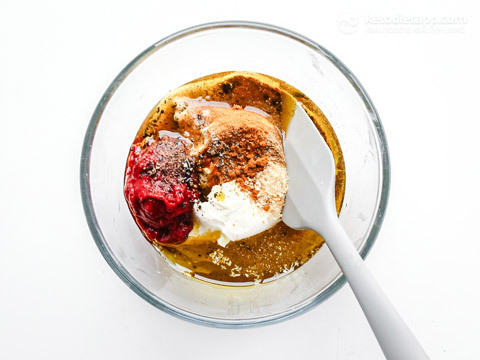
Preheat your oven to 400��F (200��C) for fan-assisted or 425��F (220��C) for conventional ovens. Once the cauliflower is cool enough to handle, cover it generously with the cheesy masala marinade, making sure to coat every part evenly.
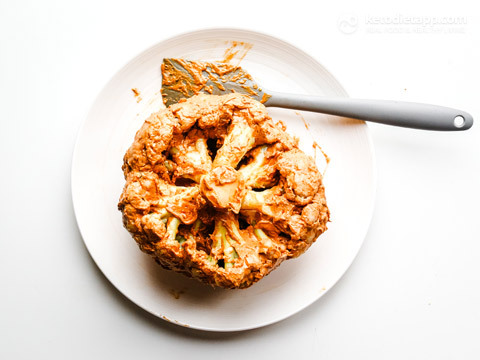
Place it on a baking tray lined with parchment paper.
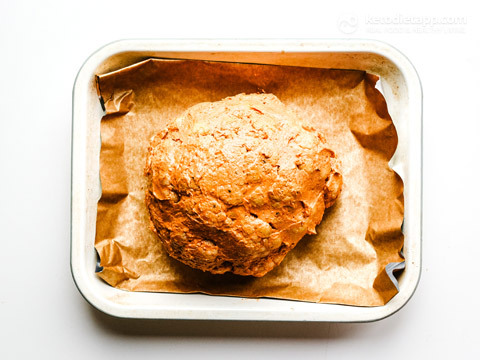
Roast the cauliflower in the oven for 30 to 35 minutes, until the coating is golden and slightly crispy. Remove it from the oven and allow it to cool for a few minutes before slicing.
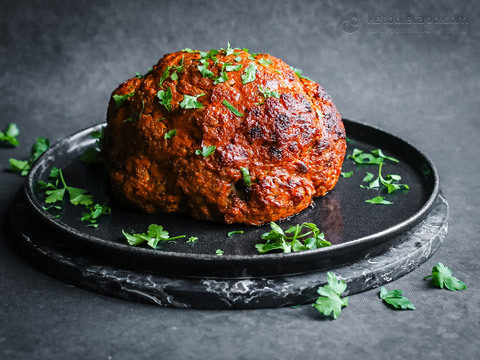
Serve warm as a side with your favorite meat dish, or enjoy it as a light meal with a dollop of sour cream or a fresh salad.

October 14, 2024
Spooky & Low-Carb: 25 Halloween Recipes You���ll Love
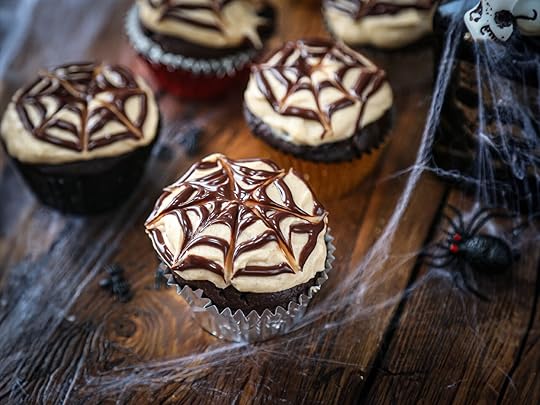
Looking for some spine-tingling treats to make your Halloween party both spooky and keto-friendly? We���ve rounded up 25 eerily delicious recipes that are low in carbs but big on flavor. From creepy crawly deviled eggs to chocolatey concoctions that scream ���boo,��� there���s something here for every ghost and goblin. Whether you're hosting a haunted gathering or just in the mood for some festive fun, these recipes will make sure you don���t miss out on the Halloween excitement���all while sticking to your keto lifestyle!
Spooky Keto Chocolate Mug Cake

When you need a quick and spooky treat, this keto chocolate mug cake is perfect for satisfying those midnight cravings. Ready in just minutes, it's rich, chocolatey, and topped with a creepy twist���perfect for Halloween! The best part? It���s single-serve and super easy to make in the microwave!
Keto Pastry Snakes

These Keto Pastry Snakes are a fun, spooky twist on traditional pastries! With a crisp, buttery crust and a playful snake shape, they���re sure to slither into the spotlight at your Halloween spread. Plus, they���re low-carb and perfect for dipping into your favorite keto-friendly sauces���a creepy and delicious way to stay festive without the blood sugar spike.
Keto Black Chocolate Hearts

Dark, mysterious, and oh-so-decadent, these Keto Black Chocolate Hearts are the perfect Halloween treat with a twist. Made with rich, velvety chocolate, they���re a spooky yet satisfying bite for everyone who is trying to keep their carbs low. The eerie black color adds an extra layer of Halloween magic, making them both a treat for the eyes and the taste buds���without any of the guilt!
Spooky Keto Chocolate Chaffles

These Spooky Keto Chocolate Chaffles take your waffle game to the dark side! With rich cocoa flavor and a crispy texture, they���re perfect for a spooky breakfast or snack. Top them with creamy "skeletons" or ���spider webs��� (or just your favorite low-carb toppings) for a fun, keto-friendly Halloween treat that���ll be a hit with both kids and adults.
Keto Chocolate & Mint Cheesecake Fluff

This Keto Black Chocolate & Mint Cheesecake Fluff is creamy, light, and has just the right kick of mint. It���s an easy, no-bake treat that���s perfect for Halloween without going overboard. Whip it up in minutes for a refreshing and fun dessert that fits right into your low-carb goals.
Halloween Cheesecake Keto Brownies

These Halloween Cheesecake Keto Brownies combine the best of both worlds���rich, fudgy brownies topped with a creamy cheesecake layer. The spooky green top makes them a festive addition to any Halloween gathering, while keeping things low-carb and delicious.
Keto Sausage Mummies

These Keto Sausage Mummies are a fun and savory treat that���s perfect for any spooky celebration. Wrapped in super simple low-carb dough and baked to golden perfection, they���re a great finger food for parties or just a fun snack at home. With their adorable mummy look, they���ll be a hit with both kids and adults���without breaking your keto goals!
Sugar-Free Sour Jelly Worms

These Sugar-Free Sour Jelly Worms are the ultimate creepy-crawly snack for your Halloween spread. They're tangy, chewy, and perfectly sour���without any of the sugar. Whether you're decorating a dessert or just want a fun snack without all the sugar, these jelly worms are sure to add a spooky touch to your holiday treats!
Creepy Eyeball Deviled Eggs

Turn a classic appetizer into a spooky treat with these Creepy Eyeball Deviled Eggs! They���re creepy to look at but tasty to eat, featuring a simple, flavorful filling with a fun eyeball design. Perfect for adding some eerie flair to your Halloween table while staying low-carb and keto-friendly.
Keto Oreo Cookies

These Keto Oreo Cookies bring a low-carb twist to a classic favorite! With their dark, crisp chocolate cookies and creamy green filling, they���re just as satisfying as the original but totally keto-friendly. Perfect for Halloween or anytime you're craving something sweet without the sugar overload. Bonus: they���re great for dunking, too!
Spooky Spiced Carrot Jellies

These Spooky Spiced Carrot Jellies are a fun twist on Halloween treats! Made with a hint of warming spices and a bit of carrot sweetness, they���re a unique low-carb option for your holiday table. Their bright color and jelly texture make them a perfect spooky addition to your keto-friendly party. make them as festive as they are tasty���perfect for adding a spooky touch to your keto-friendly party.
Spooky Blackberry Jelly Bats

These Spooky Blackberry Jelly Bats are a fun, fruity addition to your Halloween lineup! With a subtle blackberry flavor and cute bat shape, they���re sure to be a hit at any gathering. Their low-carb recipe makes them a great option for anyone looking for something festive and tasty.
Low-Carb Monster Fingers

These Low-Carb Monster Fingers are as spooky as they are tasty! Shaped like creepy fingers and topped with "nails," they���re a fun, savory treat perfect for any Halloween gathering. Made with keto-friendly ingredients, these finger foods keep things festive without the carbs, making them a hit at any party or snack table.
Low-Carb Black Heart Cupcakes

These Low-Carb Black Heart Cupcakes are a dark and delicious addition to your spooky treats! With rich, chocolatey flavor and an eerie black color, they���re perfect for Halloween festivities. Best of all, they���re completely sugar-free and gluten-free, so you can enjoy a festive dessert without worrying about the carbs.
Low-Carb Mascarpone Mousse with Blackberry and Star Anise Sauce

This Low-Carb Mascarpone Mousse with Blackberry and Star Anise Sauce is both delicious and spooky, thanks to its "bloody" red sauce. The creamy mascarpone pairs perfectly with the fruity blackberry and a hint of star anise for a fun twist. It���s easy to make and a great option when you want to add something a little different to your Halloween spread.
Spooky Chorizo Olive Eyeballs

These Spooky Chorizo Olive Eyeballs are a creepy snack that���s perfect for Halloween parties. With spicy chorizo and green olives, they���re packed with flavor and shaped like eyeballs for that extra spooky touch. Best of all, they���re low-carb and easy to make, so you can whip them up quickly for your next gathering!
Keto Monster Cookies

These Keto Monster Cookies are a fun way to get into the Halloween spirit! Decorated with playful "monster eyes," they���re sure to be a hit with both kids and adults. Whether for parties or just a spooky snack at home, these cookies bring all the fun without the extra sugar.
Low-Carb Tahini Swirl Cookies

These Low-Carb Tahini Swirl Cookies combine nutty tahini and rich chocolate into one spooky, tasty treat. Their fun swirl design makes them perfect for Halloween, adding a little flair to your snack table. Great for parties or just a quick treat to celebrate the season!
Spooky Eyeball Keto Cookies

These Spooky Eyeball Keto Cookies are fun and just the right amount of creepy! With their eerie eyeball design, they���ll bring plenty of Halloween spirit to your snack table. Full of flavor and low-carb, they���re a great addition to your festive treats.
Low-Carb Black Widow Cocktail

This Low-Carb Black Widow Cocktail has a striking, blood-red color that���s perfect for Halloween. Its refreshing flavors and spooky look make it a great addition to your Halloween celebrations, minus the sugar. A fun and festive drink to enjoy during the spooky season!
Spooky Ghost Low-Carb Pizza

This Spooky Ghost Low-Carb Pizza is a fun, festive way to bring some Halloween spirit to your meal. With creepy toppings and a low-carb crust, it���s perfect for a spooky family dinner or a party treat that everyone will love!
Low-Carb Witch Hat Cookies

These Low-Carb Witch Hat Cookies are festive, fun, and way healthier than most Halloween treats! Shaped like pointy witch hats, they add a fun vibe to your Halloween treats���though we���ve heard some people think they look more like nipples! Either way, they���re a delicious and quirky addition to your spooky snack lineup, without the carbs.
Keto Chocolate Eyeballs

These Keto Chocolate Eyeballs are a spooky, bite-sized treat perfect for Halloween! With a rich chocolate center and a creepy eyeball design, they���re fun to look at and delicious to eat. A great addition to your Halloween treats without the extra carbs.
Keto Black Spaghetti Pasta Noodles

These Keto Black Spaghetti Pasta Noodles are the ultimate spooky dinner! Their eerie black color makes them perfect for a Halloween-themed meal, and they���re low-carb too. Just pair them with your favorite sauce for a delicious, hauntingly fun dinner.
Low-Carb Spiderweb Cupcakes

These Low-Carb Spiderweb Cupcakes are both spooky and delicious! Topped with a fun spiderweb design, they���re a great addition to any Halloween celebration. The best part? They���re keto-friendly, so you can enjoy a festive treat without the sugar rush. Perfect for parties or a fun family dessert!
October 13, 2024
High-Protein Chocolate Macadamia Halva

This High-Protein Keto Chocolate Macadamia Halva is the perfect low-carb, high-protein alternative to traditional halva. It's adapted from my original halva recipe featured in The New Mediterranean Diet Cookbook, combining rich macadamia nut butter, tahini, and collagen powder for a satisfying treat that���s both nutritious and delicious.
The macadamias add a nice crunch and a healthy dose of fats, making this a great snack or dessert for keto, paleo, or low-carb diets. Plus, it���s quick to make and stores well in the fridge for up to two weeks!
Recipe Ingredients & Swaps
This recipe uses simple, keto-friendly ingredients, and there are a few easy substitutions to suit your needs.
Tahini: This adds creaminess and a rich, nutty flavor. You can swap it with almond butter or sunflower seed butter if you prefer a different flavor profile.
Macadamia Nut Butter: The buttery texture and mild taste of macadamia nut butter are perfect for this recipe. If needed, almond butter or other nut butters work well too. I LOVE House of Macadamias - get 10% off by using code KDA or simply click the link to automatically apply it.
Collagen Powder: Used for added protein and a smooth texture. If you don't have collagen, you can substitute whey protein isolate or egg white protein isolate���just make sure they're low-carb isolates, not concentrates.
Allulose: A low-carb sweetener that doesn't spike blood sugar and has a mild sweetness. If you prefer, you can substitute it with erythritol or monk fruit, but note that allulose gives a smoother texture without aftertaste.
Coconut Oil: This helps bind the ingredients together while adding healthy fats. If you prefer, you can use ghee or unsalted butter as a substitute.
Raw Cacao Powder: Adds deep, rich chocolate flavor. You can use Dutch-processed cocoa for a smoother, less acidic taste.

Where to Get Allulose
There are a few options available on Amazon. The brand I use and like is RxSugar. If you live in the US you can get RxSugar 20% off by using this link (affiliate link) or by using the code KETODIET20 at checkout. For those outside the US, it can be a bit more challenging to find, but you can order it in bulk and have it shipped to the UK.
Tips for Making the Perfect Sugar-Free Halva
To ensure your keto halva turns out perfectly, keep these tips in mind:
Soften nut butters: Gently heat the tahini and macadamia nut butter with coconut oil on low heat. This makes them easier to mix.
Powder the Allulose: Granular allulose can be a bit grainy. For a smoother texture, pulse it in a coffee grinder or food processor until powdered.
Use a parchment-lined pan: Line your pan with parchment paper to make it easy to remove and cut the halva without sticking.
Choose your nuts wisely: If you prefer roasted macadamias, roast them at lower temperatures (265��F to 300��F/ 130��C to 150��C) to preserve the healthy fats and prevent damage.
Chill thoroughly: Let the halva chill in the fridge for at least an hour before cutting, so it sets properly and cuts cleanly.
Storage
To keep your keto chocolate macadamia halva fresh, store it in an airtight container in the refrigerator for up to two weeks. If you���d like to keep it longer, freeze the halva for up to three months. When you're ready to enjoy, let the frozen halva thaw in the fridge overnight. This low-carb halva softens quickly at room temperature so always keep refrigerated until serving.

Similar Recipes You'll Love
Love low-carb smoothies? Check out some of these recipes:
High-Protein Keto Pistachio Halva
Vanilla Macadamia Keto Power Bars
Keto Maple Pecan Protein Bars



Preparation time
Hands-on: 10 minutes
Overall: 1 hour 10 minutes
Nutritional values (per bar)
Total Carbs5.1grams
Fiber2.6grams
Net Carbs2.5grams
Protein8.5grams
Fat19.9grams
of which Saturated6.1grams
Energy220kcal
Magnesium34mg (9% RDA)
Potassium113mg (6% EMR)
Macronutrient ratio: Calories from carbs (4%), protein (15%), fat (81%)
Ingredients (makes 16 servings)
3/4 cup tahini (188 g/ 6.6 oz)
1/3 cup macadamia butter (87 g/ 3 oz)
1/3 cup virgin coconut oil (80 ml)
1 cup unflavored collagen powder or whey protein isolate or egg white protein isolate (100 g/ 3.5 oz)
1/3 cup raw cacao powder or Dutch process cocoa (22 g/ 0.8 oz)
1/3 cup Allulose (50 g/ 1.8 oz)
1 tsp vanilla powder or 1 tbsp sugar-free vanilla extract
3/4 cup macadamia nuts (100 g/ 3.5 oz)
Instructions
To soften the tahini and the macadamia nut butter, place them in a small sauce- pan over low heat with the coconut oil. Remove from the heat and set aside to cool for a few minutes.
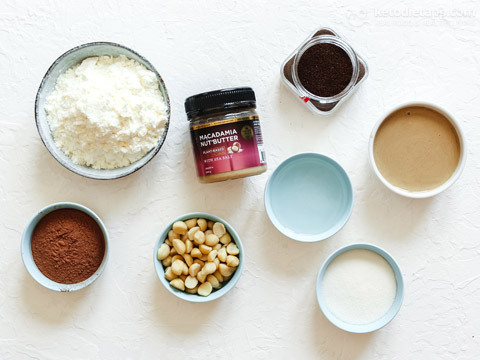
Add the remaining ingredients. Stir to combine, then pour the mixture into an 8 �� 8���inch (20 �� 20 cm) parchment-lined pan or a silicone pan, or any pan or container lined with parchment paper. Place in the fridge for at least 1 hour or until fully set.

Cut into 16 pieces and serve.
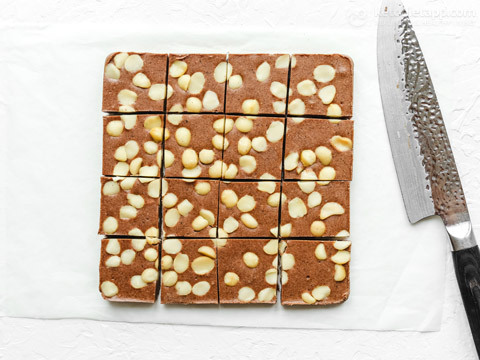
To store, keep refrigerated for up to 2 weeks or freeze to up to 3 months.

October 5, 2024
The Ultimate Guide to Squash: Low-Carb Varieties, Carb Counts, and How to Cook Them

Squash offers a wide variety of flavors, textures, and carb counts, making it a versatile addition to any low-carb or keto diet.
Summer squash varieties, like zucchini, yellow squash, and pattypan, are typically lower in carbs and are great for quick cooking methods like grilling, saut��ing, or even using as pasta substitutes. These squash are perfect for those who want to keep things light and easy in the kitchen.
On the other hand, winter squash varieties, such as butternut, spaghetti, and kabocha, bring heartier flavors and richer textures to the table. While many winter squash options are higher in carbs than summer squash, there are still lower-carb choices, like spaghetti squash and hubbard squash, that work well in keto-friendly meals. With so many different types, names, and flavors, it���s worth exploring different squash varieties to find what works best for your taste and dietary needs.
Whether you're using them for roasting, soups, stuffing, or even as a noodle substitute, squash can play a key role in a variety of delicious low-carb dishes. Just remember that some carb counts may vary slightly, so be sure to use the approximate values as a guideline.
Table of Contents
Types of Squash: Summer Squash
Zucchini
Yellow Squash
Pattypan Squash
Types of Squash: Winter Squash
Hokkaido (Onion, Red Kuri)
Delicata Squash
Butternut Squash
Honeynut Squash
Sugar Pumpkin
Acorn Squash
Hubbard Squash
Spaghetti Squash
Long Island Cheese Pumpkin
Carnival Squash
Jarrahdale Pumpkin
Kabocha Squash
Fairytale Pumpkin
Porcelain Doll Pumpkin
Tiger Stripe Squash
Cinderella Pumpkin
White (Lumina) Pumpkin
Galeux d'Eysines Pumpkin
Speckled Hound Squash
If you���ve ever wondered about the different types of squash and how they fit into a low-carb or keto lifestyle, you���re in the right place. Squash comes in many varieties, each with its own flavor, texture, and carb content. Whether you���re looking for a light side dish or a hearty ingredient to build your meal around, there���s a type of squash for just about everything.
In this guide, I���ll walk you through the most common types of squash, their carb counts, how to use them in your meals, and when you can find them at their freshest. Ready to explore all the ways you can enjoy squash while keeping things low-carb? Let���s dive in.
Types of Squash: Summer Squash
When it comes to summer squash, you���ve probably seen some familiar faces at the grocery store or farmer���s market. These squash varieties are usually softer, with thinner skin, and they cook up quickly, making them super easy to work with. Here are a few you���ll likely come across the following options.
Zucchini
Zucchini is a go-to for many people, and for good reason. It���s mild, versatile, and can be used in everything from grilling to making low-carb noodles (hello, zoodles!). It's also great for stuffing, especially the round type. Plus, it���s one of the lowest-carb squash options out there, with only about 3g of carbs per cup cooked.
Carb count (per 100 g/3.5 oz, raw): 2.1 g
Uses: Grilling, saut��ing, spiralizing for noodles, or baking into low-carb muffins, breads, cakes and smoothies where it acts as a thickener. Plus you can even make "apple" pie with zucchini - no one will know there's no apple!
Notes: One of the lowest-carb squash options, available year-round in most stores.
Recipes with zucchini:
Zucchini Spaghetti Bolognese
Homemade Zucchini Pickles
Low-Carb Czech Apple Kolache



Yellow Squash
Similar to zucchini, yellow squash has a mild flavor and soft texture. It���s a bit sweeter and can be used interchangeably with zucchini in most recipes (perfect for making "apple" pie!). Whether you slice it into a stir-fry or roast it for a quick side, it���s a great addition to any low-carb meal.
Carb count (per 100 g/3.5 oz, raw): 2.1 g
Uses: Stir-frying, roasting, or slicing into salads. Just like zucchini, it's a great option in desserts and sweet meals as with the right preparation it tastes like apple!
Notes: Like zucchini, yellow squash can be used in sweet or savory dishes and is widely available.
Pattypan Squash
Pattypan squash looks a little different with its fun, scalloped shape, but don���t let that fool you���it���s just as easy to cook with. Its firmer texture makes it great for roasting or stuffing.
Carb count (per 100 g/3.5 oz, raw): 2.6 g
Uses: Roasting, stuffing, or slicing into stews.
Notes: Its unique scalloped shape makes it fun to cook with, and it���s most commonly found in summer.
Recipes with zucchini and pattypan squash:
Bacon & Egg Stuffed Pattypan Squash
Chorizo & Mushroom Stuffed Round Zucchini
Deviled Zucchini & Egg Hash



Types of Squash: Winter Squash
Winter squash comes in many shapes, sizes, and flavors���some of which you might not have heard of before! What makes it even trickier is that many of these squash varieties go by different names. For example, you might see Hokkaido squash labeled as Red Kuri or Onion squash, depending on where you shop. So, if you���ve ever found yourself confused at the grocery store, don���t worry���you���re not alone!
Below is a look at the most common types of winter squash, along with their carb counts and some ideas on how to use them in your low-carb or keto meals. Although they are all edible, some types are best used for ornamental purposes.
Note: For some squash varieties, the nutrition information may be approximate (marked with a "~") due to variations in size, ripeness, and sourcing. These values should be used as general guidelines.
Hokkaido (Onion, Red Kuri)
Also known as Red Kuri or Onion squash, Hokkaido squash has a distinct shape and color. This bright orange squash is often favored for its sweet, nutty flavor and smooth texture. One of the main benefits is that Hokkaido can be roasted with the skin on, which softens beautifully during cooking.
Carb count (per 100 g/3.5 oz): 7g
Uses: Roasting, soups, or purees.
Notes: Known for its sweet, nutty flavor and bright orange skin.
Recipes with hokkaido squash:
Pumpkin Soup with Chorizo Crumb
Pumpkin, Sage & Browned Butter Zoodles
Roasted Pumpkin Soup



Delicata Squash
Delicata squash might not be as well-known, but it���s worth a try! It has a delicate, sweet flavor and a thin skin that you don���t even need to peel before cooking. This makes it one of the easiest winter squashes to work with.
Carb count (per 100 g/3.5 oz, raw): 7g
Uses: Saut��ing or roasting.
Notes: Thin skin makes it easy to cook without peeling.
Butternut Squash
Butternut squash is probably the most popular winter squash. Its creamy, sweet flesh makes it perfect for soups, purees, and roasting. While it���s higher in carbs than summer squash, its flavor and texture are hard to beat.
Carb count (per 100 g/3.5 oz, raw): 9.7g
Uses: Soups, roasting, and mashing.
Notes: A go-to for many fall dishes, though a bit higher in carbs.
Recipes with butternut squash:
Low-Carb Butternut Squash Lasagna
Pumpkin Pie Spiced Butternut Chips
Low-Carb Baked Butternut Cups



Honeynut Squash
This small, sweet squash looks like a mini butternut squash but has an even richer flavor. It���s packed with sweetness, making it a great choice for roasting or blending into soups, though its carb content is a bit on the higher side.
Carb count (per 100 g/3.5 oz, raw): 9.8g
Uses: Roasting, soups, or purees.
Notes: Sweeter than butternut squash and rich in flavor.
Sugar Pumpkin
Sugar pumpkins (pie pumpkins) are smaller and sweeter than the larger pumpkins you might carve at Halloween. They���re great for baking and cooking, offering a rich, smooth texture and a natural sweetness that works well in soups and pies.
Carb count (per 100 g/3.5 oz, raw): 6.5g
Uses: Baking, soups, and pies.
Notes: Smaller and sweeter than jack-o���-lantern pumpkins.
Recipes with sugar pumpkin:
How To Make Pumpkin Puree with Two Ingredients
Keto Basque Burnt Pumpkin Cheesecake
Keto Pumpkin Pie Spiced Waffles



Acorn Squash
Acorn squash has a slightly sweet, nutty flavor and is perfect for roasting or stuffing. Its flesh is a bit firmer than butternut, and while it���s higher in carbs, it makes for a hearty side dish when balanced with low-carb ingredients.
Carb count (per 100 g/3.5 oz, raw): 8.9g
Uses: Roasting, stuffing, or baking.
Notes: A bit higher in carbs, but perfect for hearty fall meals.
Hubbard Squash
Hubbard squash is known for its large size and tough, bumpy skin. While it can look a bit intimidating, its sweet and flavorful flesh makes it a great choice for soups and casseroles. Plus, it���s lower in carbs than most other winter squash varieties.
Carb count (per 100 g/3.5 oz, raw): 4.8g
Uses: Roasting or baking.
Notes: Often found in soups and casseroles; lower in carbs than some other winter squash.
Spaghetti Squash
If you���re looking for a pasta substitute, spaghetti squash is your best friend. Once cooked, its flesh pulls apart into noodle-like strands, making it perfect for low-carb meals like spaghetti or stir-fries. It���s also much lower in carbs than most other winter squash, which is a bonus.
Carb count (per 100 g/3.5 oz, raw): 5.4g
Uses: Pasta substitute, baking.
Notes: A great low-carb alternative to traditional noodles.
Recipes with spaghetti squash:
How To Cook Spaghetti Squash the Right Way
Low-Carb Chorizo Stuffed Spaghetti Squash
Low-Carb Spaghetti Squash Breakfast Nests



Long Island Cheese Pumpkin
Named for its flat, wheel-like shape resembling a cheese wheel, the Long Island Cheese pumpkin has a dense, sweet flesh. It���s a great option for pies and soups, with a rich flavor that can hold its own in hearty dishes.
Carb count (per 100 g/3.5 oz, raw): ~6g
Uses: Baking, pies, or soups.
Notes: A classic American variety that���s great for traditional pumpkin dishes.
Carnival Squash
Carnival squash is a beautiful mix of colors, often orange, yellow, and green, with a sweet, mild flavor similar to acorn squash. It's great for roasting or using in soups, and its vibrant colors make it visually appealing on the plate.
Carb count (per 100 g/3.5 oz, raw): 7g
Uses: Roasting, stuffing, or adding to soups.
Notes: A close relative of acorn squash, with a slightly sweeter flavor.
Jarrahdale Pumpkin
This Australian heirloom pumpkin has blue-gray skin and dense, sweet orange flesh. It���s similar to other pumpkins but with a unique look and slightly sweeter taste. It���s perfect for pies, soups, and roasting.
Carb count (per 100 g/3.5 oz, raw): 5.2g
Uses: Roasting, soups, or pies.
Notes: Its sweet flavor and dense texture make it great for hearty dishes.
Kabocha Squash
Kabocha squash, also known as Japanese pumpkin, has a sweet, rich flavor and creamy texture, making it ideal for soups or roasting. It���s a little lower in carbs than butternut but still something to enjoy in moderation if you���re watching your carb intake.
Carb count (per 100 g/3.5 oz, raw): 7g
Uses: Roasting, soups, or stews.
Notes: Similar to pumpkin but creamier and slightly sweet.
Recipes with kabocha squash:
Baked Salmon, Avocado & Pumpkin Bowls
Pumpkin, Chorizo & Feta Tray Bake
Roasted Pumpkin Salad with Feta & Rocket



Fairytale Pumpkin
This pumpkin variety lives up to its name, with its whimsical shape and deep orange flesh. It has a sweet, rich flavor, and its dense flesh holds up well in hearty fall recipes.
Carb count (per 100 g/3.5 oz, raw): 7.2g
Uses: Roasting, soups, and stews.
Notes: Known for its deep orange flesh and sweet flavor.
Porcelain Doll Pumpkin
Porcelain Doll pumpkins are as beautiful as they are tasty. With their pale pink skin and sweet flesh, they add a unique visual appeal to seasonal dishes. They can be used for roasting or pies, much like other sweet pumpkin varieties.
Carb count (per 100 g/3.5 oz, raw): ~6g
Uses: Roasting or in pies.
Notes: A unique pink-skinned variety often used in seasonal dishes.
Tiger Stripe Squash
With its striking stripes and colorful skin, Tiger Stripe squash is a standout both visually and in flavor. Its sweet, nutty flesh is great for roasting, soups, and baking.
Carb count (per 100 g/3.5 oz, raw): 6g
Uses: Roasting, soups, or baking.
Notes: Its colorful skin makes it a decorative option too.
Cinderella Pumpkin
Cinderella pumpkins are famous for their shape (think of the pumpkin from the fairy tale!), but they���re also delicious. They have a sweet, tender flesh that���s ideal for roasting or baking into pies.
Carb count (per 100 g/3.5 oz, raw): ~7g
Uses: Roasting, baking, or purees.
Notes: Named for its resemblance to the pumpkin in Cinderella, it���s popular for both decorative and culinary uses.

White (Lumina) Pumpkin
White pumpkins aren���t just for decoration. Lumina pumpkins have a slightly milder flavor compared to sugar pumpkins but are great for soups, pies, or roasting. Their striking white skin makes them a favorite around Halloween and Thanksgiving.
Carb count (per 100 g/3.5 oz, raw): ~7g
Uses: Baking, soups, or roasting.
Notes: While often used for ornamental purposes, they can be cooked similarly to sugar pumpkins.
Galeux d'Eysines Pumpkin
This unique French heirloom pumpkin is known for its warty, salmon-colored skin. Despite its odd appearance, it has a sweet, velvety flesh that works well in soups, pies, and baking.
Carb count (per 100 g/3.5 oz, raw): 7.2g
Uses: Soups, pies, or baking.
Notes: Often used in French cuisine for its creamy texture and sweet flavor.
Speckled Hound Squash
This decorative squash has a unique, speckled green, orange, and white skin. It���s not just for looks, though���it has a mild, slightly sweet flavor that works well for roasting or adding to stews.
Carb count (per 100 g/3.5 oz, raw): ~7g
Uses: Roasting or in soups.
Notes: Its vibrant colors make it a popular choice for fall d��cor as well.

September 12, 2024
Is This the End of Erythritol? What This Study Means for Low-Carb Recipes

Recent studies suggest that erythritol might increase the risk of blood clots, especially in people with pre-existing conditions like cardiovascular disease, diabetes, or clotting disorders.
However, the research has its limitations: the study involved a relatively small group of participants, tested a higher amount of erythritol (30g), involved the consumption of erythritol in isolation, and measured blood levels only once rather than at multiple intervals. Additionally, the study focused solely on short-term effects.
As someone with Factor V Leiden, a condition that raises my risk of clotting, I���ve personally cut back on erythritol, balancing it with other sweeteners like allulose and stevia. While I���m not eliminating it entirely, I���m mindful of how much I use.
For many, erythritol is still a useful option in low-carb and keto recipes, but it���s important to stay informed and make choices based on your own health.
In recipes, erythritol plays a crucial role in providing bulk, sweetness, and texture���especially in baked goods. It���s not always easy to replace, but alternatives like allulose, xylitol, monk fruit, and stevia can work, depending on the recipe.
Table of Contents
The First Erythritol Study: A Recap of Previous Concerns
The New Erythritol Study: What���s New?
Breaking Down the Methods
Study Limitations: What���s Missing?
1. Highly Controlled Consumption
2. Single Blood Test Timing
3. Short-Term Focus
4. Relatively Small Sample Size
Is 30 Grams of Erythritol a Lot?
Who Should Be Concerned About Erythritol?
My Approach: A Balanced Perspective
The Role of Erythritol in Recipes: Is it Easy to Replace?
1. Sweetness with Bulk
2. No Bitter Aftertaste
3. Crucial for Crunch
4. Less Expensive
5. Widely Available
6. Almost Zero Calories
Conclusion
Have you ever found yourself rethinking something after hearing more about it? That���s exactly where I���ve been with erythritol lately. After writing about it before, I���ve taken some time to really think through the latest research and what experts have been saying. So, if you���re like me and want to get to the bottom of things���especially when it comes to something that���s in our food���stay with me.
Now, this might be a bit longer, but I promise it���ll be worth your time (and if you���re short on time, there���s always the TLDR!). You���ll hear a lot about erythritol online, from health influencers to food bloggers, but the real question is: Should you be worried?
As I���ve always said, I���m not a scientist, just someone who loves science, trying to understand what���s out there. I've done my best to carefully weigh the findings without jumping to conclusions. This isn���t about telling you to love or leave erythritol, but about sharing what the latest study says, and whether it might change the way we think about it in our keto recipes.
The First Erythritol Study: A Recap of Previous Concerns
So, before we dive into the new study from August 2024, let���s quickly revisit what had us all talking in the first place. Last time, we discussed how this study from 2023 showed a possible link between high erythritol levels and an increased risk of cardiovascular events���think heart attacks and strokes. The idea was that erythritol might make your platelets (those tiny blood cells that help clots form) more ���sticky,��� potentially increasing the risk of clots.
I know, it sounded a bit alarming. But at that point, I urged caution instead of panic. After all, while the findings were concerning, the real-world implications weren���t totally clear. Was erythritol really the cause? Or could it be that people with higher cardiovascular risks were just more likely to consume it? That���s where the debate really began.
The New Erythritol Study: What���s New?
Now, here���s where things get interesting. The new study looked at what happens when people consume erythritol versus glucose. They took 20 healthy volunteers and gave them either 30 grams of erythritol (yep, that same amount you might find in some of your favorite keto treats, or at least the sweeter ones) or glucose, then measured how their platelets responded.
The results? Erythritol led to significantly higher platelet activity, which means it could increase the risk of blood clots. Glucose didn���t have the same effect, making erythritol the one under the spotlight here.
What does that mean for you and me? Well, it suggests that erythritol could affect how our blood clots, especially if we consume it in larger amounts. It���s a bit of a red flag, but as always, there���s more to the story.
Breaking Down the Methods
Let���s take a quick peek at how the researchers figured all of this out. They didn���t just make assumptions���they got into the nitty-gritty. The study involved 20 healthy volunteers, split into two groups: one drank a solution with 30 grams of erythritol, and the other had glucose. Then, the researchers measured platelet reactivity before and after.
This point is important because unlike the previous study, which primarily examined participants with cardiovascular conditions, this study focused on healthy individuals. The earlier research raised some questions about whether pre-existing health issues could have influenced the results. This new study provided clarity by showing that even in healthy people, erythritol could lead to an increased risk of clot formation.
What did they find? Erythritol led to a big spike in platelet activity, meaning those platelets were more likely to form clots. The results were pretty consistent across participants.
But here���s an important note: the study only looked at what happened over a short period of time, just 30 minutes after consumption. So, while it���s telling us something about immediate effects, we don���t yet know how erythritol might affect us in the long run.
Study Limitations: What���s Missing?
As with any study, there are a few limitations worth noting���some mentioned by the researchers, and others that become clear when we dig deeper.
1. Highly Controlled Consumption
In this study, participants fasted overnight and consumed either erythritol or glucose on an empty stomach. This doesn���t exactly mirror how we typically consume sweeteners in real life. Most of us include erythritol in foods or drinks that also contain fat, protein, or fiber���nutrients that can slow down the absorption process. Consuming erythritol in isolation gives us limited insight into how it affects our bodies when it's part of a balanced meal.
2. Single Blood Test Timing
The study measured the participants��� blood levels only once, 30 minutes after consumption. This doesn���t give us the full picture. Blood sugar levels, for example, fluctuate at different times after eating, so it���s likely erythritol levels would too. Testing at additional intervals���like 1 or 2 hours post-consumption���would have provided more comprehensive data about how erythritol behaves in the bloodstream over time, similar to what they did in the previous study in 2023.
3. Short-Term Focus
The focus was on immediate, short-term effects, which are useful but don���t tell us much about what happens over longer periods. We still don���t know how moderate, repeated erythritol consumption affects the body after days, weeks, or even months. This makes it difficult to draw conclusions about its safety for regular, long-term use.
4. Relatively Small Sample Size
The study only involved 20 participants, which is a relatively small group. While the results were consistent, a larger sample size would give us more confidence in the findings and allow for a broader range of health conditions and lifestyles to be factored in.
Is 30 Grams of Erythritol a Lot?
Some critics of this study argue that 30 grams of erythritol is too much���but is it? The amount consumed in the study���30 grams���may seem high to some, but for those who regularly consume erythritol, it���s not that uncommon.
From my experience creating low-carb recipes, certain keto treats can contain close to this amount. For example, a chocolate mug cake with frosting could easily have 30 grams of sweetener if you eat the whole thing. Of course, not everyone would eat that much, especially after getting used to low-carb eating, when sweet cravings tend to fade.
And it���s not just homemade recipes. Ready-made products like bars and drinks often contain significant amounts of sweeteners, and the total can quickly add up. So, while 30 grams might sound like a lot, for regular consumers of keto desserts or sweetened snacks, it���s not entirely unrealistic.
Bottom line: These limitations don���t erase the findings, but they remind us that there���s still a lot more to understand about erythritol���s role in our diets���especially in real-world settings.
Who Should Be Concerned About Erythritol?
Now, this is where things get personal. Should you be worried about erythritol based on this study? Well, I���m not here to give you definitive answers���after all, that���s not my place, and it���s a decision that���s deeply personal, depending on your own health situation.
The study does raise concerns, particularly for people who already have health conditions that make them more prone to blood clots or cardiovascular issues. If you have a history of heart disease, diabetes, or clotting disorders, it might be worth paying closer attention to your erythritol intake. It���s also something to consider for those at higher risk of cardiovascular events due to age or other factors.
My Approach: A Balanced Perspective
As for myself, with Factor V Leiden (a genetic condition that increases my risk of blood clots), this puts me in one of the groups who might need to be more careful. During my pregnancy and a few months postpartum, I was on blood thinners to manage this risk. While I haven���t noticed any adverse effects from my erythritol use, it���s something I���ve kept in mind ever since the initial studies came out in 2023.
Since then, I���ve cut back on my erythritol consumption���not eliminating it completely, but balancing it with other sweeteners like allulose, monk fruit, or stevia extract. And just to be clear, I never consume erythritol in large quantities anyway���certainly not the 30 grams they tested in the study. But I do use it moderately in recipes, and I���m comfortable with that for now. Just to give you an idea, I still have the same bag of erythritol from 2023 when the last study came out.
Ultimately, we all have to evaluate our own comfort level with the potential risks. For some, cutting back might be the right move; for others, the occasional use in moderation might feel fine. As always, it's a matter of understanding the science and making informed choices that suit your own health and lifestyle. As I said before, for me Erythritol is not an essential ingredient.
The Role of Erythritol in Recipes: Is it Easy to Replace?
For those of us who enjoy low-carb or keto baking, erythritol is more than just a sweetener���it���s a crucial ingredient in achieving the right texture and taste in many recipes. Unlike some other sugar substitutes, erythritol brings a unique combination of properties that make it particularly valuable in baking and desserts.
1. Sweetness with Bulk
Erythritol is about 60-70% as sweet as sugar, and unlike concentrated sweeteners like stevia or monk fruit, it adds bulk to recipes. This is especially important in baked goods where texture matters, like cookies, cakes, or muffins. Allulose and xylitol also provide sweetness with bulk.
2. No Bitter Aftertaste
One of erythritol���s biggest selling points is that it has little to no aftertaste, unlike some sweeteners that can leave a lingering bitterness. This makes it a popular choice in desserts where flavor is key. However, it does have a cooling effect, which some people notice as an aftertaste, though most don���t mind it.
3. Crucial for Crunch
In recipes like Keto Shortbread Cookies or crunchy biscuits, erythritol is what provides that crisp texture we all love. If you swap it for something like allulose, you���ll end up with a chewier result, which may or may not be what you���re looking for. There is no alternative to Erythritol that would help you achieve the same crunchy results. If you use allulose or xylitol, you will end up with softer, chewier cookies.



4. Less Expensive
While allulose is gaining popularity for its similar properties, it���s still more expensive than erythritol or xylitol. If you're using sweeteners regularly in your recipes, erythritol is generally a more budget-friendly option, making it accessible for everyday use.
5. Widely Available
Another big advantage of erythritol (and also xylitol) is that it���s widely available in most countries, whereas allulose is still relatively new and not yet sold everywhere. If you live outside the U.S., you may find it harder to get your hands on allulose, whereas erythritol can usually be found in most supermarkets and online. That said, Allulose was recently approved in Australia, which is great news for its growing availability.
6. Almost Zero Calories
Compared to xylitol, which is also commonly available, erythritol has the benefit of being almost calorie-free (just like allulose). It contains about 0.2 calories per gram, whereas xylitol contains 2.4 calories per gram���much closer to regular sugar. Also, while xylitol is toxic to dogs, erythritol is considered safe for pets, which is something to keep in mind if you have furry friends at home.
In short, while erythritol plays an important role in low-carb recipes, it���s not irreplaceable. Depending on what you're baking or cooking, you can experiment with substitutes that suit your needs while balancing any health concerns you may have. Just be mindful of how different sweeteners affect the final outcome in terms of sweetness, texture, and availability.
Conclusion
Erythritol remains a popular choice for many following a low-carb or keto lifestyle, but the recent studies have raised some important questions, especially for those with specific health concerns. While the research has limitations, staying informed and making thoughtful choices is key. Whether you continue using erythritol or explore alternatives like allulose, monk fruit, or stevia, the best approach is to choose what works for your health and personal preferences.
September 10, 2024
The Best Low-Carb Strawberry Tiramisu

I���m so excited to share something special today! If you���re a fan of my Classic Keto Tiramisu (which received rave reviews!), you���ll love this fruity twist. This Low-Carb Strawberry Tiramisu is light, creamy, and bursting with fresh strawberry flavor. It���s the perfect dessert for any occasion and, of course, it���s keto, sugar-free, and gluten-free. Our newsletter subscribers got a sneak peek, and now it���s time for everyone to enjoy!
Why This Recipe Is So Good
Low-Carb & Keto-Friendly: Made with keto ingredients to keep carbs low.
Fresh Strawberry Twist: Uses fresh strawberries and sugar-free syrup for natural sweetness.
Creamy & Light: Mascarpone, whipped cream, and sour cream create a perfect balance of texture.
Gluten-Free Ladyfingers: Almond and coconut flour-based, making them gluten-free and keto-friendly. They are just as light and sweet as regular ones!
Caffeine-Free and Alcohol-Free: Unlike traditional tiramisu, this version skips the coffee and booze, making it ideal for everyone!
Recipe Tips and Swaps
This Low-Carb Strawberry Tiramisu is already packed with great flavors and keto-friendly ingredients, but there are always a few ways to customize it based on your preferences or what you have on hand. Here are some tips and easy swaps:
Sweetener: Allulose works well here for a smooth texture, but you can also use powdered Erythritol or monk fruit sweetener. Just be mindful that different sweeteners may vary in sweetness, so adjust to taste. Also note that Allulose won't make these ladyfingers as crunchy as Erythritol but in this case it doesn't matter as they will be soaked in syrup anyway.
Flour Options: The combination of coconut and almond flour gives the ladyfingers the perfect structure. If you're out of coconut flour, swap it with more almond flour, but increase the amount by about four times since coconut flour is more absorbent.
Strawberry Syrup: If you don't have time to make the Sugar-Free Strawberry Syrup (which is really easy!), you can blend fresh strawberries with a little keto sweetener for a quick alternative. This keeps it fresh and fruity!
Mascarpone Substitute: If you can't find mascarpone, cream cheese can be used instead. It will slightly change the flavor, closer to a cheesecake, but it will still work well in the cream layer.
Berry Powder Topping: The optional topping of strawberry, beetroot or dragonfruit powder adds a pop of color, but if you don't have those, just skip it or use extra fresh strawberries for garnish.
Tips for the Best Low-Carb Strawberry Tiramisu
To make sure your tiramisu turns out just right, here are a few helpful tips:
Whip the Cream Properly: Make sure to whip the mascarpone, heavy cream, and sour cream until they form soft peaks. Over-whipping can make the mixture too stiff. Under-whipping would not firm up properly.
Don���t Overbake the Ladyfingers: Almond flour burns easily. Keep an eye on the ladyfingers while they bake to prevent them from becoming too dry. They should be golden to light brown. Anything over that might make them bitter. Rotating the tray once or twice will help you avoid a disaster.
Chill for Best Results: Super important! Allow the tiramisu to chill for at least 2 hours (longer is better). This helps the flavors meld and the texture firm up.
Cut Clean Slices: For cleaner slices, use a sharp knife and wipe it between cuts to avoid dragging the cream layer.
Storage Tips
Store the tiramisu in the fridge, covered, for up to 4 days. For longer storage, freeze it for up to 1 month and thaw in the fridge before serving.
Low-Carb Recipes You Will Love
Love anything tiramisu? Here are more keto recipes you should try!
Classic Low-Carb Tiramisu
Tiramisu Brownie Celebration Cake
Tiramisu Brownie Slice
Tiramisu Chia Pudding
Tiramisu Poke Cake
Tiramisu Popsicles







Preparation time
Hands-on: 30 minutes
Overall: 3-4 hours
Nutritional values (per serving, 1 slice)
Total Carbs10.1grams
Fiber2.3grams
Net Carbs7.8grams
Protein9grams
Fat32.7grams
of which Saturated17.8grams
Energy371kcal
Magnesium36mg (9% RDA)
Potassium248mg (12% EMR)
Macronutrient ratio: Calories from carbs (9%), protein (10%), fat (81%)
Ingredients (makes 8 servings)
Ladyfingers:
6 large eggs, separated
1/4 tsp cream of tartar or 1/2 tsp lemon juice
1/2 cup powdered low-carb sweetener like Allulose (80 g/ 2.8 oz)
4 tbsp coconut flour (32 g/ 1.1 oz)
2/3 cup almond flour (67 g/ 2.4 oz)
pinch of sea salt
1 tsp sugar-free vanilla extract or 1/4 tsp vanilla bean powder
Strawberry soak:
1/2 cup homemade Sugar-Free Strawberry Syrup (120 ml/ 2 fl oz)
Cream layer
1 pack mascarpone cheese (250 g/ 8.8 oz)
1 cup heavy whipping cream (240 ml)
1 3/4 cups sour cream (400 g/ 14.2 oz)
1/4 cup powdered low-carb sweetener like allulose (40 g/ 1.4 oz)
Fine zest from 1/2 organic lemon
1 tsp sugar-free vanilla extract
400 g fresh strawberries (14.1 oz)
Optional for topping: freeze-dried strawberry powder, beetroot powder, or dragonfruit powder (I used a mixture of 1/2 tbsp beetroot and 1/2 tbsp dragonfruit)
Instructions
Before you start, make sure you've got the Sugar-Free Strawberry Syrup. You can prepare it now or while the ladyfingers are baking. If Prepare the ladyfingers. Preheat the oven to 160 °C/ 320 °F (fan assisted), or 180 °C/ 355 °F (conventional).
Line a baking tray with parchment paper. Separate the egg whites from the yolks. Cream the yolks with the powdered sweetener until pale and creamy.
In another bowl, whisk egg whites with cream of tartar (or lemon juice) until stiff peaks form.

Fold the egg yolk mixture into the egg whites, followed by the vanilla. Sift in the coconut and almond flour, then gently combine.

Spread the mixture onto the lined tray (26 cm x 26 cm/ 10 inch x 10 inch) and bake for 15 minutes.
Lower the oven temperature to 140 °C/ 285 °F (fan assisted), or 160 °C/ 320 °F (conventional), and bake for another 30 minutes, rotating the tray halfway.

Let the ladyfingers cool for 5 minutes before cutting into 24 pieces.
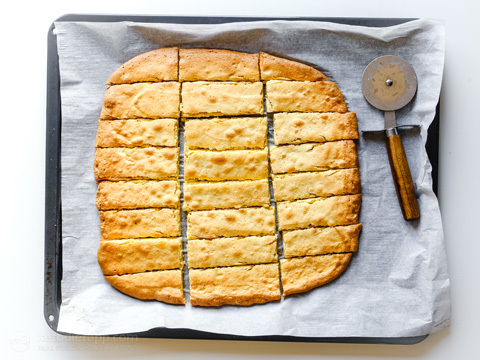
Prepare the cream layer by whipping mascarpone, whipping cream, powdered sweetener, lemon zest, and vanilla until fluffy.
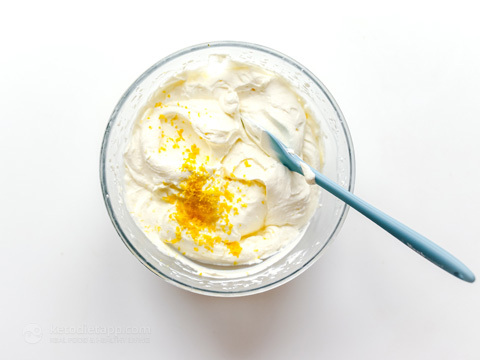
When ready to assemble, start by layering half of the ladyfingers drizzled with half of the strawberry syrup in a 30 cm x 20 cm (12 inch x 8 inch) dish.
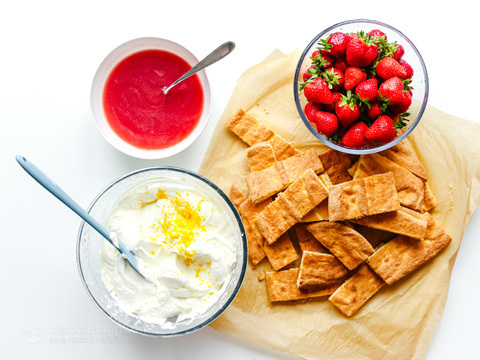
Add half of the sliced strawberries, and half of the cream mixture.
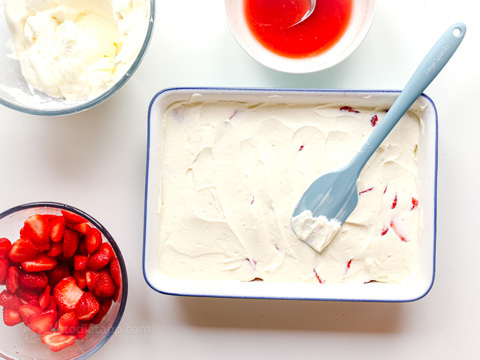
Repeat the layers. Add the remaining ladyfingers drizzled with the remaining strawberry syrup. Top with the remaining strawberry slices, and finally add the remaining whipped cream mixture.

Smoothen with a spatula. Dust with berry powder if desired, or use more sliced strawberries for topping. Chill in the fridge for 2 hours before serving, and enjoy!
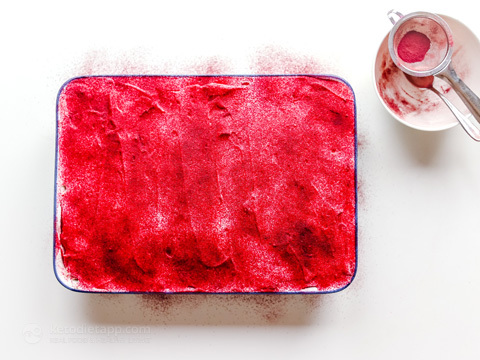

August 25, 2024
Can You Have This While Fasting? 5 Foods and 5 Drinks That Won���t Break Your Fast!

Fasting isn���t just about skipping meals���it���s about making smart choices that keep you on track without breaking your fast. Whether you���re fasting for weight loss, metabolic health, or deeper benefits like autophagy, what you eat and drink during a fast depends on your goals.
When it comes to drinks, water, black coffee, and tea are your safest options. They���ll keep you hydrated and energized without affecting your fast. Bone broth and apple cider vinegar can be useful, especially during longer fasts, but keep in mind they contain minimal calories.
Some fasting protocols allow for small amounts of fats like MCT oil, coconut oil, or even bone broth. These can provide a boost during extended fasts without disrupting your goals. Supplements like electrolytes are essential for staying hydrated, especially during longer fasts, and sugar-free options like zero-carb gummies can help satisfy cravings.
In the end, fasting can be flexible, but it���s key to the right fasting approach what works best for your body and your goals.
Are you following a low-carb/keto diet and want to give fasting a try? Get the annual KetoDiet App membership 25% off - click here to claim yours!
Table of Contents
What is Technically a Fast?
Your Fast, Your Goals
What Can You Drink During a Fast?
1. Water
2. Black Coffee
3. Tea
4. Bone Broth
5. Apple Cider Vinegar
What Foods and Supplements Can You Have During a Fast?
1. Fats
2. Gum and Mints
3. Supplements
4. Electrolytes
5. Zero-Carb Gummies
Frequently Asked Questions About Fasting
Can I use sweeteners like allulose, stevia, xylitol, or erythritol without breaking my fast?
Is it okay to drink diet soda while fasting?
Can taking supplements affect my fast?
What should I do if I feel very hungry or weak during a fast?
How does drinking coffee or tea affect my fast?
Can I have bone broth during a fast, and how does it affect my fasting goals?
Conclusion
Are you trying out fasting or considering it? If you've ever wondered exactly what you can eat and drink without breaking your fast, you're in the right place. Fasting isn't just about skipping meals���it's about smart choices that help you stay on track.
In this guide, we'll break down the drinks and snacks that fit perfectly within your fasting window, keeping you on track without breaking your fast. Plus, if you're curious about how adding keto can boost your fasting efforts, check out our detailed guide here.
What is Technically a Fast?
At first glance, fasting sounds simple���just stop eating, right? But there's more to it if you want to make sure you're getting the most out of it without accidentally breaking your fast.
Technically, a fast means sticking to very few or no calories. ( Longo et al, 2014) That said, you can still enjoy certain drinks and even some supplements as long as they don't push your body out of the fasting state.
The key is knowing how your body responds to what you're consuming. For example, pure fats like MCT oil or butter may not spike your insulin, so they���re often considered okay for some fasting methods. Still, some people argue that any calories technically break the fast.
It all comes down to your fasting goals���whether you're focused on weight loss, boosting metabolism, or getting deeper health benefits.
Your Fast, Your Goals
The types of foods and drinks you can consume during a fast really depend on your goals. Let���s break it down:
Weight Loss: If losing weight is your focus, keeping insulin levels low is key. ( Hall et al, 2017) You might wonder, ���Can I have anything at all?��� Sticking to zero-calorie drinks like water, black coffee, and tea will keep your insulin in check and help your body stay in fat-burning mode.
Improved Metabolism: Maybe you���re looking to give your metabolism a boost. In that case, adding a bit of MCT oil to your coffee could help. ( St-Onge et al, 2010) It won���t raise your insulin, and it can provide an energy boost, making your fast easier to manage.
Autophagy and Health Benefits: If your goal is deeper health benefits like autophagy (your body���s way of cleaning out damaged cells), then keeping it strict is important. ( Levine et al, 2008) Stick to water and herbal teas to keep this process going strong.
As you can see, what you choose to consume during your fast depends on what you���re hoping to achieve.
What Can You Drink During a Fast?
Now that you know how to align your fasting goals, you might be asking, ���What can I drink while fasting?��� Here���s what works without breaking your fast.
1. Water
Water is your best friend during a fast. Whether it���s still or sparkling, feel free to add a squeeze of lemon or lime for a bit of flavor without adding calories.
2. Black Coffee
Need a caffeine fix? Black coffee is a popular choice and won���t break your fast. ( Heckman et al, 2010) Just skip the sugar and cream to keep things in check.
3. Tea
Green, black, or herbal tea works well too. It���s a great way to stay hydrated and keep things interesting. Just remember, no sweeteners.
4. Bone Broth
Bone broth is a bit of a gray area. While it does contain some calories, it���s packed with electrolytes (super important during a fast!) and can be a good option for longer fasts when you need a little extra support. It���s a good option if you���re fasting for more than a day and need to replenish minerals and stay hydrated. Plus you can easily make bone broth at home!
5. Apple Cider Vinegar
Diluting a couple of tablespoons of apple cider vinegar in water can help can help curb hunger and stabilize blood sugar levels, especially during extended fasts.
Each of these options will help you stay hydrated and energized, without breaking your fast.



What Foods and Supplements Can You Have During a Fast?
While traditional fasting means no food, some fasting styles allow for a little wiggle room when it comes to certain foods and supplements. Here's what you might consider.
1. Fats
A bit controversial, but some people include small amounts of fats like coconut oil, MCT oil, or grass-fed butter in their coffee or tea (often called "Bulletproof coffee"). These fats can provide energy without spiking insulin levels, making them helpful during longer fasts. ( Heidt et al, 2023)
2. Gum and Mints
If you need to freshen your breath or curb your appetite a bit, sugar-free gum or mints are generally safe. Just make sure they don���t contain any hidden sugars or carbs that could affect your insulin.
3. Supplements
Most calorie-free supplements, like multivitamins, are fine to take during a fast. However, fat-soluble vitamins (like vitamins A, D, E, and K) are best taken with food, so it���s better to save those for your eating window.
4. Electrolytes
Electrolytes like sodium, potassium, and magnesium are especially important during longer fasts. You can find electrolyte supplements without sweeteners, or make your own Electrolyte Drink using a small amount of lime or lemon juice. To beat the summer heat you can even make a Slurpee out of it!
Get 15% off Perfect Keto Electrolytes and their fasting bundles. You can either use this link or apply code KDA at checkout.
5. Zero-Carb Gummies
You, this is true, you can even have gummies! For a little something sweet that won���t break your fast, zero-carb gummies are a great option. They���re made with zero-calorie sweeteners, tea or water and the optional sugar-free flavorings. They can even include electrolytes to help you stay hydrated. Try making your own with these easy recipes for Zero-Carb Gummies and Electrolyte Gummies.



Frequently Asked Questions About Fasting
Can I use sweeteners like allulose, stevia, xylitol, or erythritol without breaking my fast?
Yes, these sweeteners don���t contain calories and generally don���t impact your blood sugar. However, everyone���s different���some people may still experience cravings or slight insulin responses, so pay attention to how your body reacts.
Is it okay to drink diet soda while fasting?
While diet soda is calorie-free, it���s not always the best choice. Artificial sweeteners can sometimes trigger cravings and affect blood sugar levels for some people. If you���re aiming for a clean fast, it���s better to stick to water, black coffee, or tea.
Can taking supplements affect my fast?
Most supplements won���t break your fast, especially if they���re calorie-free. However, fat-soluble vitamins (like A, D, E, and K) are best taken with food, so it���s better to have those during your eating window for better absorption. If you do include a "bulletproof coffee", then it's good to take your fat-soluble vitamins with it.
What should I do if I feel very hungry or weak during a fast?
Mild hunger is normal, but if you feel weak or light-headed, it���s important to listen to your body. You can drink some water with electrolytes or have a small amount of bone broth to replenish minerals. If the symptoms persist, it might be a sign to break your fast.
How does drinking coffee or tea affect my fast?
Plain black coffee or tea is perfectly fine during fasting and can even help curb hunger. Just avoid adding sugar, milk, or cream to keep your fast intact. A small splash of unsweetened nut milk is usually okay if you need it.
Can I have bone broth during a fast, and how does it affect my fasting goals?
Bone broth contains a few calories but is often used during longer fasts because of its mineral content. It won���t keep you in a strict fast, but it���s a good option if you���re fasting for weight loss or looking to stay hydrated and nourished during an extended fast.
Conclusion
Fasting is more than just skipping meals���it's about making choices that help you stick to your goals. Whether you're fasting for weight loss, better metabolism, or deeper health benefits, the right drinks and snacks can help you stay on track without breaking your fast. Water, black coffee, tea, and even small amounts of fats like MCT oil can give you energy and keep your fast intact. Remember, the best approach is one that fits your body and goals, so feel free to adjust as needed.
August 18, 2024
21 Easy No-Cook, Protein-Packed Meals to Beat the Summer Heat

When the summer heat hits, the last thing you want is to turn on the stove or oven. That���s why these no-cook, easy-to-make keto meals are perfect for staying cool while staying on track with your low-carb lifestyle.
Whether you're whipping up a quick lunch, meal prepping for the week, or craving something refreshing and light, these dishes are packed with protein and flavor. From fresh salads to creative wraps and sushi-inspired bites, these recipes are perfect for those hot days when you want a fuss-free meal.
Tricolore Burrata Salad

This light and flavorful salad brings together juicy tomatoes, creamy burrata, and avocado, making it a great choice for hot days. Drizzled with olive oil and balsamic vinegar, it���s simple yet delicious. You can also add a dash of truffle oil for extra flavor. Perfect as a quick lunch or side dish.
Bacon & Avocado Chaffle Sandwich

This Bacon & Cheese Chaffle Sandwich is a delicious, low-carb meal that���s quick to make. The chaffles are made from eggs, cheese, and almond flour, creating a light, crispy base. Filled with crispy bacon and creamy avocado, it���s perfect for an easy lunch or even breakfast. These sandwiches are also great for meal prep and can be stored for later use. Need a dairy-free option? You can swap the cream cheese with mayo and make this low-carb bread instead!
Crab Salad Cucumber Stacks

Looking for a light, protein-packed meal? These cucumber stacks are topped with a creamy crab salad made from fresh crab meat and mayonnaise. The crisp cucumber slices add a refreshing crunch, making it perfect for warm weather. Serve it as a stack, or mix things up by using the crab salad as a dip with keto-friendly veggies.
Avocado Shrimp Ceviche Salad

This ceviche is a refreshing, no-cook dish that's ideal for warm days. It features cooked shrimp, diced avocado, tomatoes, jalape��o, and red onion, all tossed in a zesty lime and lemon juice marinade. Serve it chilled over lettuce for a light, flavorful meal. It's a perfect combination of protein and healthy fats, making it great not just for diabetics.
Creamy Sardine Salad

If you���re looking for a quick, high-protein option, this sardine salad delivers. A mix of sardines, mayo, and a touch of lemon, it���s simple yet packed with flavor. It pairs perfectly with crunchy veggies, keto toast, or can be stuffed into avocado halves for a light, refreshing meal.
No-Cook Bento Lunchbox

This No-Cook Bento Lunchbox is perfect for busy days when you need a quick, grab-and-go meal. It features a variety of low-carb goodies like cheese, deli meats, nuts, and fresh veggies, all neatly packed in a bento box. This setup is versatile, allowing you to mix and match your favorite no-cook keto-friendly ingredients for a balanced, satisfying lunch that���s easy to prepare and enjoy.
Shrimp & Avocado Salad with Seafood Sauce

This refreshing Shrimp & Avocado Salad combines cooked shrimp with creamy avocado, served on a bed of lettuce and drizzled with a tangy seafood sauce made from mayo, sugar-free ketchup, and Worcestershire sauce. It���s a light, protein-packed meal perfect for warm summer days, ready in just 10 minutes.
Everything Bagel Stuffed Baby Peppers

For a quick, crunchy bite, these baby bell peppers are filled with a mix of cream cheese, ham, and provolone, then topped with everything bagel seasoning. This easy no-cook snack is perfect for summer days and packs a lot of protein. It���s a fun, fresh option when you need something simple but satisfying.
Cobb Salad in a Jar

A jar is used for a Cobb Salad to keep ingredients fresh by layering them strategically���dressing at the bottom and delicate greens at the top. This prevents sogginess, ensuring the salad stays crisp until it���s ready to eat. Convenient and portable, it���s perfect for meal prep and transport. Alternatively, any lunchbox container will do.
Creamy Tuna Cucumber Boats

Creamy tuna salad served in cucumber boats makes for a refreshing, no-cook meal. The tuna is mixed with mayonnaise, Dijon mustard, and red onions, then spooned into cucumber halves for a light and cooling dish. It's a perfect high-protein, low-carb lunch or snack for hot summer days, ready in just 10 minutes. For added freshness, top with spring onions or chives.
Creamy Egg & Avocado Salad Pepper Boats

Stuffed with a creamy mix of avocado, hard-boiled eggs, mayo, and mustard, these pepper boats are an easy, no-cook option for a quick keto meal. The crisp peppers add a satisfying crunch to the rich filling, making this dish both refreshing and filling. Perfect for meal prep or a light lunch.
Mexican Shrimp Gazpacho

This chilled Mexican Shrimp Gazpacho is a refreshing, low-carb meal packed with flavors from tomatoes, cucumber, jalape��o, and lime. The cold soup is blended with olive oil for creaminess and topped with grilled shrimp, avocado, and fresh veggies for extra texture and protein. It���s a perfect make-ahead option for hot summer days as it needs to chill for a few hours before serving.
No Cook Keto Tuna Pasta

Palmini noodles make a light, refreshing base for this quick tuna dish. Tossed with lemon, olive oil, capers, and olives, the tuna pasta comes together in under 10 minutes, requiring no cooking. It's a perfect meal for summer days when you want something easy and protein-packed without heating up the kitchen.
Bell Pepper Sandwich with Bacon, Ham & Cheese

For a quick and crunchy low-carb meal, bell peppers serve as a base for a filling of bacon, ham, and cheese. Cream cheese adds richness, while everything bagel seasoning provides extra flavor. It���s perfect for a no-cook, refreshing sandwich alternative, ideal for hot days or quick lunches on the go.
Cold Plate with Smoked Salmon

A simple, no-cook dish that���s perfect for hot days, this cold plate features smoked salmon, avocado, and cucumber, served with a creamy herb dip. Ready in just five minutes, it's packed with healthy fats, protein, and fresh flavors. You can customize it by adding eggs or more smoked salmon for extra protein.
Buffalo Chicken Chopped Salad

This tasty Buffalo Chicken Chopped Salad combines diced chicken tossed in a buttery buffalo sauce with crispy bacon, blue cheese, and avocado, all on a bed of fresh lettuce and veggies. It���s a high-protein, low-carb meal that���s perfect for meal prep or a quick lunch, and it holds up well in the fridge. Just add the avocado right before serving to keep it fresh.
Tuna Poke Stuffed Avocados

Fresh and simple, these Tuna Poke Stuffed Avocados are perfect for a light, no-cook meal. Sashimi-grade tuna is mixed with tamari, sesame oil, and cucumber, then spooned into avocado halves for a refreshing, high-protein dish. The combination of creamy avocado and flavorful tuna makes this a satisfying summer lunch that comes together in just minutes.
Italian Sub Roll Ups

Italian Sub Roll-Ups are a quick, no-cook alternative to the classic sandwich. Made with ham, pepperoni, provolone cheese, and lettuce, they���re drizzled with a tangy mayonnaise-based sauce and rolled up for easy eating. These keto-friendly wraps are perfect for meal prep or a fast lunch, offering plenty of protein while keeping carbs low.
Smoked Salmon & Avocado Sushi Rolls

A quick and easy no-cook meal, these keto-friendly sushi rolls are made with smoked salmon, avocado, cucumber, and red bell pepper, all wrapped in nori seaweed. With just five ingredients and five minutes of prep time, they���re perfect for a light lunch or snack. Serve with coconut aminos, pickled ginger, and wasabi for an extra burst of flavor.
Creamy Pesto Tuna Salad

A twist on traditional tuna salad, this recipe combines tuna with pesto, mayonnaise, and Greek yogurt for a creamy, flavorful dish. It's served over crisp lettuce, cucumber, tomato, and avocado, with a simple olive oil and lemon dressing. This salad is quick to prepare and perfect for meal prep, offering a high-protein, low-carb option that���s refreshing for warmer days.
Ham & Cheese Unwich with Sriracha Mayo

This lettuce wrap unwich is packed with ham, pepperoni, cheese, avocado, and pickles, all drizzled with a spicy sriracha mayo. Wrapped tightly in crisp lettuce, it's a quick, no-cook meal perfect for lunch or meal prep. With just five minutes of prep time, this high-protein, low-carb option is both simple and satisfying.




